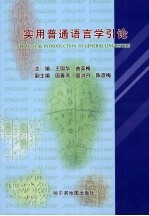
- 作 者:王国华,曲英梅主编
- 出 版 社:哈尔滨:哈尔滨地图出版社
- 出版年份:2007
- ISBN:9787807176343
- 标注页数:154 页
- PDF页数:164 页
请阅读订购服务说明与试读!
订购服务说明
1、本站所有的书默认都是PDF格式,该格式图书只能阅读和打印,不能再次编辑。
2、除分上下册或者多册的情况下,一般PDF页数一定要大于标注页数才建议下单购买。【本资源164 ≥154页】
图书下载及付费说明
1、所有的电子图书为PDF格式,支持电脑、手机、平板等各类电子设备阅读;可以任意拷贝文件到不同的阅读设备里进行阅读。
2、电子图书在提交订单后一般半小时内处理完成,最晚48小时内处理完成。(非工作日购买会延迟)
3、所有的电子图书都是原书直接扫描方式制作而成。
Chapter one Language and Linguistics 1
1.1 What is language? 1
1.1.1 Design features of human language 3
1.1.2 Functions of language 6
1.1.3 Origin of language 7
1.2 What is linguistics? 8
1.2.1 Fundamental distinctions in linguistics 8
1.2.2 Scope of linguistics 11
1.2.3 Characteristics of modern linguistics 12
Study Questions: 12
Chapter Two Phonetics 15
2.1 Speech sounds 15
2.1.1 Sound segments 15
2.1.2 Transcription of speech sounds 15
2.2 Division of phonetics 16
2.3 Classification and description of speech sounds 17
2.3.1 Voicing 17
2.3.2 Classification and description of English consonants 18
2.3.3 Classification and description of vowels 22
2.3.4 Natural classes of speech sounds 24
Study Questions: 25
Chapter Three Phonology 28
3.1 The study of sound systems and patterns 28
3.2 Phonemes,phones and allophones 28
3.3 Discovering phonemes 30
3.3.1 Minimal pairs and sets 30
3.3.2 Contrastive distribution 30
3.3.3 Complementary distribution 31
3.3.4 Free variation 31
3.3.5 The discovery procedure 31
3.4 Distinctive features and non-distinctive features 32
3.5 Phonological rules 33
3.6 Syllables and clusters 33
3.7 Prosodic phonology and suprasegmental phonology 34
Study questions: 36
Chapter Four Morphology 39
4.1 Morphemes 39
4.1.1 Morpheme,morph and allomorph 39
4.1.2 Classification of morphemes 40
4.2 Morphological process of word-formation 44
4.2.1 Compounding 45
4.2.2 Derivation 46
4.2.3 Conversion 46
4.2.4 Other ways of word-formation 47
Study questions: 49
Chapter Five Syntax—Sentence patterns 51
5.1 The traditional approach 52
5.2 The structural approach 53
5.3 The generative approach 55
5.3.1 Tenets of generative grammar 56
5.3.2 Generative approach 59
5.4 Functional approach 70
5.4.1 Systemic grammar 71
5.4.2 Functional grammar 74
Study questions: 78
Chapter Six Semantics 80
6.1 The meaning of'meaning' 80
6.2 Some views concerning the study of meaning 81
6.2.1 The naming theory 81
6.2.2 The conceptualist view 81
6.2.3 Contextualism 82
6.2.4.Behaviorism 83
6.3 The study of lexical meaning 83
6.3.1 Sense and reference 83
6.3.2 Classification of lexical meanings 84
6.3.3 Lexical Sense relations 85
6.3.4 Componential analysis of meaning 88
6.3.5 Prototype theory 89
6.4 The study of sentence meaning 89
6.4.1 Sense relations between sentences 89
6.4.2 The analysis of Sentence meaning 91
Study questions: 96
Chapter Seven Discourse Analysis 99
7.1 Historical development of discourse analysis 99
7.2 Definition of discourse analysis 100
7.3 Basic framework for the study of discourse 101
7.3.1 Language as system and as activity 101
7.3.2 Language use with purpose and function 103
7.3.3 Language in situation 104
7.4 Cohesion 107
7.4.1 Reference 108
7.4.2 Ellipsis 110
7.4.3 Conjunction 110
7.4.4 Lexical cohesion 111
7.5 Coherence 111
7.6 Schema Theory 112
Study questions: 114
Chapter Eight Pragmatics 116
8.1 What is pragmatics? 116
8.1.1 Context 116
8.1.2 Scope of pragmatics 117
8.2 Deixis 118
8.2.1 Defining deixis 118
8.2.2 Types of deixis 119
8.3 Conversational analysis 119
8.3.1 Conversational implicature 120
8.3.2 Conversational principles 122
8.4 Speech act theory 123
8.5 Presuppositions 126
8.6 Politeness Principle(PP) 126
8.7 Communication and relevance 129
8.8 Conversation analysis 130
Study questions: 133
Chapter Nine Language Culture and Society 136
9.1 Relationship between language and culture 136
9.1.1 Sapir-Whorf hypothesis 138
9.1.2 Culture in language teaching classroom 140
9.2 Language and society 140
9.2.1 Relationship between language and society 140
9.2.2 About sociolinguistics 142
9.2.3 Some basic methodological concern 143
9.2.4 Sociolects 144
9.2.5 Idiolect 148
9.2.6 Style,register and jargon 148
Study questions: 150
Bibliography 152
